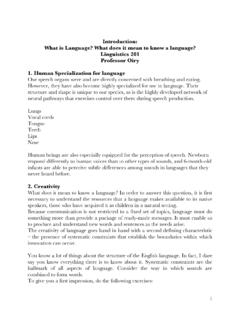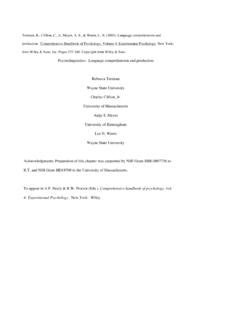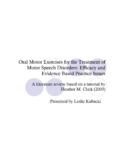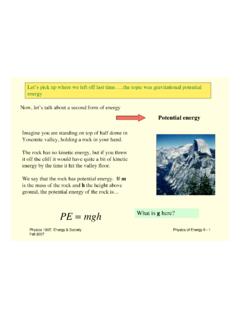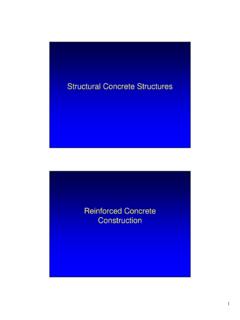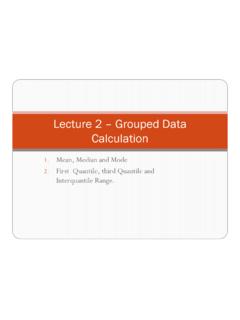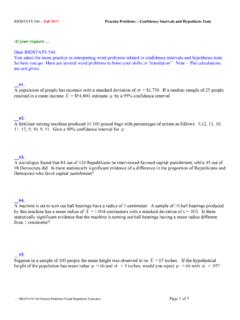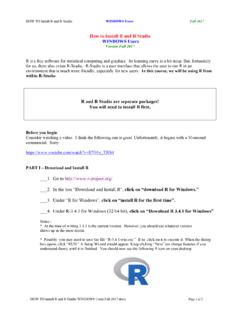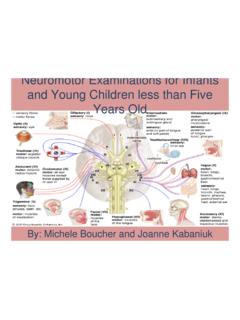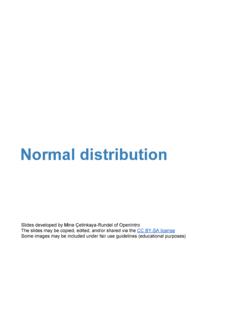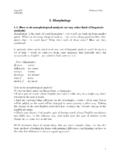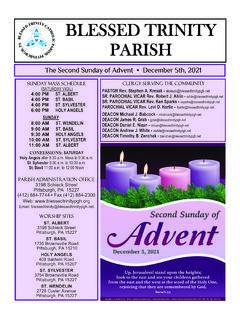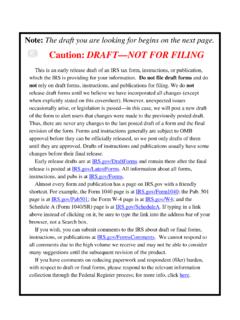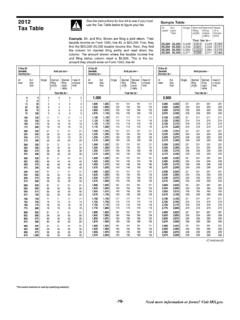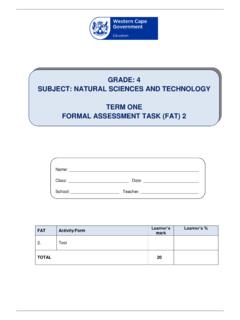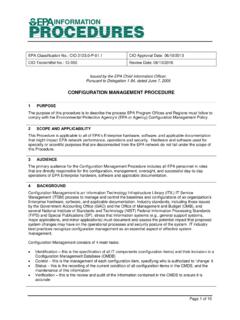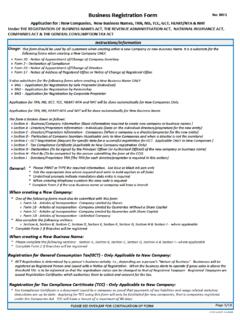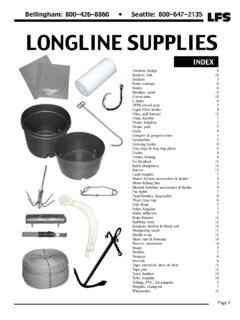Transcription of 2. PHONETICS AND PHONOLOGY 2.1 Sounds of English ... - …
1 Fall 2009 Professor Oiry ling 201 2. PHONETICS AND PHONOLOGY Sounds of English The study of the Sounds of human language is called PHONETICS . PHONOLOGY is concerned with the properties of Sounds and the ways that they are combined into words. Important: Sounds , in the sense that we discuss them, are totally different from letters. A word like through has seven letters (t-h-r-o-u-g-h), but only three Sounds (th-r-ough). DO NOT CONFUSE LETTERS AND Sounds . As you may have noticed, with the first exercise we did worked on, the letters of our writing system do not correspond to the actual Sounds we make in pronouncing the words in a very straightforward way.
2 That makes it hard to talk about Sounds in terms of the written alphabet. For one thing, it s easy to be tricked into thinking the same Sounds are involved in different words that partially contain the same letters, even though the actual Sounds might be very different. And furthermore, it s difficult to refer to a particular sound, since most, if not all, letters can be pronounced in more than one way in different words. Exercise 1: Below is a list of words that are, in one way or another, similar to each other. Try to find all the Sounds that differ in the two words!
3 A) think - sink e) beetle - needle b) though thought f) bought boat c) buy - bye g) tough fluff d) light - bite h) match - mash Linguists have therefore devised a phonetic alphabet: a system of symbols that directly represent Sounds . We write the words using the International Phonetic Alphabet (IPA), which uses one unique symbol for every sound. This means that Sounds like sh, that is spelled with two letters, can be written with just one symbol, [ ]. This avoids confusion like about when a sequence of letters sh stands for one sound, like in wash, or for two, like in misheard.
4 The other thing to do when writing Sounds (rather than letters) is to put them in brackets, like above where I talked about the sound [ ]. This helps because sometimes the IPA symbols look like regular English letters, and so putting them in brackets makes it very clear that you re using them as Sounds , not letters. The important parts: When spelling words, write them like this (or this), in italics (or underline). Fall 09 Professor Oiry ling 201 2 When writing Sounds , write them like [Is], using IPA symbols and brackets. The following table gives you a first overview of a number of English consonants.
5 The symbol in the beginning is a character from the International Phonetic Alphabet (IPA). Next, there is a word of English that contains that sound (in the place of the underlined letter). Finally, there is a complete transcription of the word in IPA symbols. Exercise 2: For each sound, give one more example. If possible, if the given example has the sound at the beginning of the word, give an example where it is at the end of a word and vice versa. p pat [p t] thick [ Ik] d judge [d d ] b bat [b t] D the [ i] m mat [m t] t pat [p t] s sat [s t] n gnat [n t] d pad [p d] z zip [zIp] sing [sI ] k cat [k t] wash [w ] l last [l st] g get [g t] garage [g ra ] r rat [r t] f fat [f t] h hat [h t] v vat [v t]
6 T match [m t ] A notational convention: [IPA] vs. English Note that it is extremely important to be clear about whether we are using IPA symbols or letters of the English alphabet, especially because most Roman letters also are symbols in the IPA. With the tool of IPA symbols at hand, let s go back to some of the examples from the exercise above: a) think - sink b) though thought c) bought boat d) match mash Classifying Sounds by Articulatory Features So far, we have only introduced a new notation to talk about Sounds . That s a useful tool, but it is only a first step towards classifying Sounds by their properties.
7 Our next step towards understanding the sound system of English therefore is to address the questions of how Sounds differ from one another and which Sounds are similar in certain ways. One piece of evidence indicating that we have unconscious knowledge about what Sounds are similar in certain ways comes from the entertaining sport of Fall 09 Professor Oiry ling 201 3 misunderstanding song lyrics. Consider the following examples (from ): The real lyrics were: That's me in the corner, That's me in the spotlight. But I misheard them as: Let's pee in the corner, Let's pee in the spotlight. Madonna: The real lyrics were: Like a virgin touched for the very first time.
8 But I misheard them as: Like a virgin touched for the thirtyfirst time. Jimmy Hendrix: The real lyrics were: 'Scuse me, while I kiss the sky But I misheard them as: 'Scuse me, while I kiss this guy. Nirvana The real lyrics were: Here we are now, entertain us But I misheard them as: Here we are now in containers Group Exercise: Find 10 pairs of Sounds (from the IPA chart above) that you think are similar in some way! Don t worry about getting this right or wrong. This exercise is simply about trying out your intuitions about Sounds . Fall 09 Professor Oiry ling 201 4 The way that has proven to be most useful in phonological research for classifying Sounds is by characterizing how the Sounds are articulated in the human vocal tract.
9 As far as consonants are concerned, we can distinguish three aspects of their articulation: place of articulation, manner of articulation, and voicing (state of the glottis is it vibrating or not (voiced or voiceless)). Table of English consonants places manner bilabial Labio-dental Inter-dental Alveolar Palatal Palato-alveolar Velar Glottal Stop p b f v t d k g Fricative s z h Affricate Nasal m n Lateral l Rhotic r Shaded: voiced Unshaded: voiceless Manner of articulation (what kind of thing your head is doing) Stop No air comes out of the mouth (or nose) at first, because the tongue or lips are fully closed and block it; then the tongue or lips open up and air comes out (sometimes in a strong burst).
10 Test: Put your mouth in position to start saying the sound. Try to exhale. If you can t make air leave your lungs because your vocal tract is completely closed, it s a stop. Fricative The tongue or lips come very close to each other (or to the teeth, or roof of the mouth) and make a very small opening, which air hisses through, making a friction like sound. Test: Make the sound for a while, and put your hand in front of your mouth. If you hear continuous hissing, and/or can feel air quickly leaving your mouth, it s a fricative. Affricate The mouth is closed at first, as in a stop; then it opens a little bit into position for a fricative.
